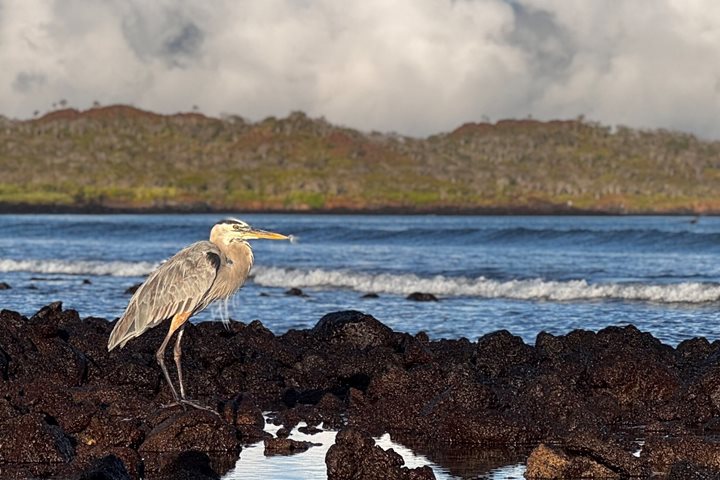Located at the central part of the archipelago, North Seymour and Rabida Islands offer a great number of attractions, not only from the point of view of marine life, but also geologically. We were fortunate to have excellent weather conditions today, and after breakfast we headed to North Seymour, a small and flat island which is home to thousands of sea birds. From a distance it looked dry and barren, covered with dry vegetation, but walking inland we observed how different and unique this place is. Land iguanas, blue-footed boobies, magnificent and great frigatebirds were delightful to our guests, who observed many different chicks with their fluffy feathers and male frigatebirds with their inflated red sacks, producing unmistakable calls, trying to obtain a mate. Heading inland, we encountered frigatebird chicks awaiting a meal from their parents, as they sat atop rickety nests that appeared to fall apart as they rested upon them. Land iguanas slowly moved in and out of the dry brush, and we came upon one that was trying—unsuccessfully—to rip apart a pad from the opuntia prickly pear cacti. We began to understand the complex process of evolution that began millions of years ago, and the poor conditions that these creatures had learn to survive, after an accidental arrival from the mainland.
When we arrived to the coast, the terrain changed dramatically, and we observed many blue-footed boobies pointing at the sky and bringing their wings forward with a very loud whistle, with the intent of attracting a mate. The females appeared to be uninterested, as they turned their backs to the dancing boobies. Along the shallows, baby sea lions swam freely between the rocks, and swallow-tailed gulls nested, protecting their eggs.
Before noon, the National Geographic Endeavour started sailing west to Rabida Island. It welcomed us with its characteristic red shores. Due to the volcanic origins, there is a large amount of iron oxide trapped in the flows and cinders of the island, which causes this red coloration. The underwater realm awaited us, and we started our exploration with deep water snorkeling along the coast. We observed some white-tipped reef shark, a school of razor surgeonfish and several sea turtles. Blue-chin parrotfish nibbled upon the reef, which produces part of the sand that is found here. After snorkeling, we disembarked on the red sandy beach, observing several Galapagos sea lions, oystercatchers and mockingbirds. Probably one of the most excited moments was the sight of a flamingo flying and landing on the lagoon located behind the red beach. We approached very closely to observe as this bird fed on small crustaceans, moving its bill very quickly through the water to devour food. It was almost 6 o’clock when we realized that we had to head back to our ship. With a soft breeze and the last beams of sun we closed our eyes, remembering all the innocent creatures and incredible places that we visited today, which will remain in our memories forever.







